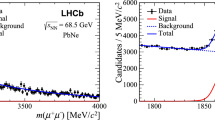Abstract
We derive, in model-independent way, the spin structure of the matrix element for the reaction of associative Θ+-pentaquark production, π ± + d → Θ+ + Σ±, in the threshold region and in collinear kinematics. The expressions for the polarization observables in this reaction are found assuming spin 1/2 and different parities for Θ+. We have proved that such a reaction can be used for a model-independent determination of the P parity of Θ+ only by measuring the Θ+ polarization. Other polarization observables, such as the dependence of the Σ± polarization on the vector and tensor deuteron polarizations, are insensitive to the Θ+ parity under the considered kinematical conditions. The linear and quadratic relations between polarization observables in \(\pi ^ \pm + \vec d \to \Theta ^ + + \vec \sum ^ \pm \) (Θ+ is unpolarized) do not depend on the parity of the Θ+ pentaquark. The analysis performed for this reaction is also applicable without any modification to the reaction K + + d → Θ+ + p. Using the pole model for the reaction mechanism, we estimated the value of the cross section for the reaction K + + d → Θ+ + p near the threshold.
Similar content being viewed by others
References
E. Golowich, Phys. Rev. D 4, 262 (1971).
D. Diakonov, V. Petrov, and M. Polyakov, Z. Phys. A 359, 305 (1997).
T. Nakano et al., Phys. Rev. Lett. 91, 012002 (2003); V. V. Barmin et al., Yad. Fiz. 66, 1763 (2003) [Phys. At. Nucl. 66, 1715 (2003)].
Fl. Stancu, hep-ph/0408042.
R. Jaffe and F. Wilczek, hep-ph/0401034.
V. Kubarovsky and P. Stoler, hep-ex/0409025.
M. P. Rekalo and E. Tomasi-Gustafsson, Eur. Phys. J. A 22, 119 (2004), and references therein; hepph/0402277.
W. Chinowsky and J. Steinberger, Phys. Rev. 95, 1561 (1954).
V. P. Nomokonov and M. G. Sapozhnikov, Fiz. Élem. Chastits At. Yadra 34, 189 (2003) [Phys. Part. Nucl. 34, 94 (2003)].
D. Allasia et al., Phys. Lett. B 174, 450 (1986).
W. W. Buck and F. Gross, Phys. Rev. D 20, 2361 (1979).
M. Lacombe, B. Loiseau, J. M. Richard, and Vinh Mau, Phys. Rev. C 21, 861 (1980).
R. V. Reid, Ann. Phys. (N.Y.) 50, 411 (1968).
F. E. Close and Q. Zhao, Phys. Lett. B 590, 176 (2004).
S. Chekanov et al., Phys. Lett. B 591, 7 (2004).
A. Airapetian et al., Phys. Lett. B 585, 213 (2004).
Author information
Authors and Affiliations
Additional information
The text was submitted by the authors in English.
Rights and permissions
About this article
Cite this article
Gakh, G.I., Rekalo, A.P. & Tomasi-Gustafsson, E. Θ+-Pentaquark parity from associative baryon production in πd collisions, π ± + d → Θ+ + Σ± . Phys. Atom. Nuclei 69, 909–914 (2006). https://doi.org/10.1134/S1063778806050140
Received:
Accepted:
Issue Date:
DOI: https://doi.org/10.1134/S1063778806050140




